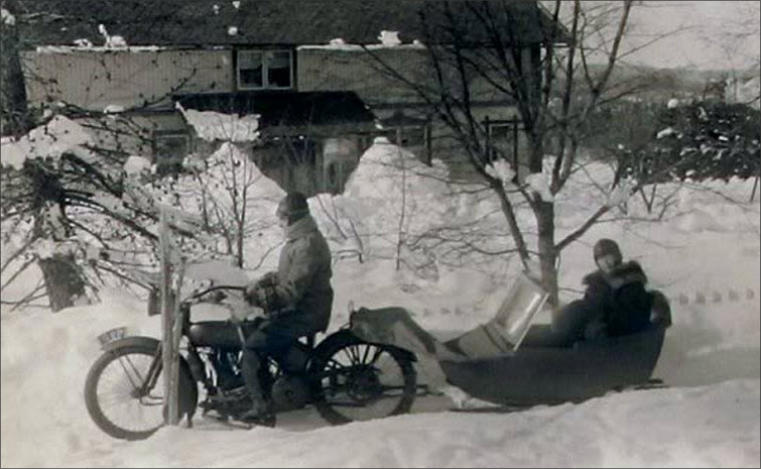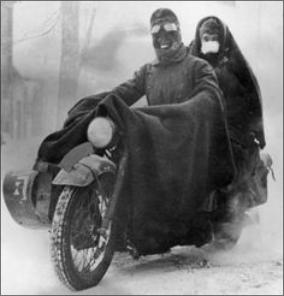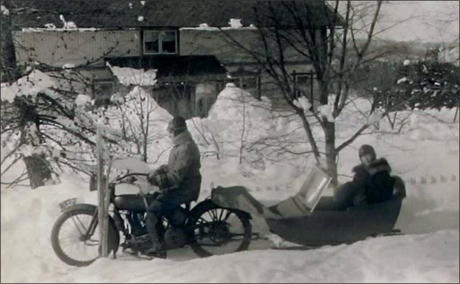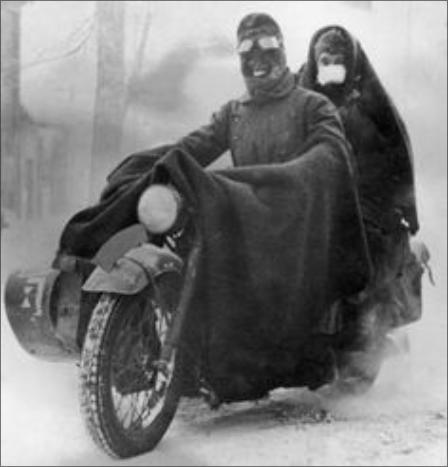

Riding in the Cold
As cold weather starts to roll in this season and the last red leaves fall off the trees, it's time to start thinking
about what you're going to do with your motorcycle this winter. For some, winter means buying fuel stabilizer,
dusting off the trickle charger, and gently snuggling their motorcycle into a warm corner of the garage. For the
rest of us, winter means no change to our motorcycle riding habits except the addition of some extra clothing!

Riding a motorcycle in cold weather comes down to one simple concept: INSULATION. Since most people aren't
very active on a motorcycle, their body isn't doing much to produce heat on its own to counteract the cold.
That means we have to do everything we can to insulate the body in order to keep what precious heat that we do
produce actually on our body, and not floating off in the cold winter air.
Insulation boils down to two things: layers (to slow the rate at which our body loses heat), and wind proofing
(to keep the wind from stealing our heat).
Let's talk about layers first. Layers are critical for riding a motorcycle in the cold weather of winter. The number
of layers you'll need to wear is based both on personal preference (some people naturally run a little hotter than
others) and the temperature outside. I've worn up to four layers in really cold weather. The key is to have enough
layers on that you feel comfortable (maybe even slightly warm) when you step outside and just stand in place
(before you ride your motorcycle).
Remember two things
• Your bottom layer should always be some type of snug fitting thermal or fleece underwear. This will create a
warm layer of air between your body and this material (Don't worry about buying the expensive wicking
materials like Dri-Fit, etc. - you won't be sweating much so it won't do you much good).
• Don't wear so many layers that you lose mobility. If you can't hold your arms at your side because of all your
clothing, than it's probably time to invest in either some warmer, or even heated, clothing.

Wind Proofing
Now, let's talk about wind proofing. The biggest issue that you will have
when riding a motorcycle in the winter is keeping the wind out. Wind,
specifically wind chill, is your worst enemy on a motorcycle in cold
weather. Doing everything you can to stop this enemy is going to go a
long way to helping you ride your motorcycle comfortably in the cold.
Wind-proofing also takes the most trial and error to perfect. It can take
quite a while before you finally plug all of those air leaks! The main thing
to do for wind-proofing is to make sure your outer layer is some type of
wind-proof material. Leather is by far the most popular choice for this.
Ideally, you should look for something that is both wind-proof and
water-proof. There are many man-made materials that meet that criteria. (I personally prefer leather and if I
do run into weather, I just throw my rain gear on for protection and a little added warmth!)
Hands and Feet
I've found that I can insulate my body and legs adequately, but when the temperature really drops, I have the most problems with my hands and feet.
Many people have a similar problem. The reason is that as you get cold your body focuses circulation on your internal organs to keep them warm, while
your feet and hands get the shaft.
The only way that I've found to keep my hands and feet comfortable in really cold weather is to 1) add additional heat sources, and 2) invest in quality
boots and gloves. For me, I invested in heated gloves, socks and jacket liners from Gerbing.
Heated Liners
Sometimes no matter how well you dress, if you're on the road long enough, you'll lose more heat than your body can generate. Long riders resort to
electrical assistance.
Heated clothing, which uses your bike's electrical system to power heating elements, makes a huge difference by not just insulating you, but adding heat
to the whole equation. Gloves start around $100. Vests, depending on the style, run around $200. Socks can range from simple D-cell powered items
that sell for around $25, to $90 systems that hook into the rest of your electric riding gear. Make sure your charging system can handle the load.
Find out the output of your charging system, add up the draw from all your electrical gear, and make sure you're not draining your battery. Also, leave a
margin of error, because your bike's output may be measured at cruising rpm’s and it may produce considerably less electrical power at idle.
For many riders, a vest alone is enough. If you keep your torso warm, your body will focus on pumping warm blood to your extremities. If you torso gets
cold, your body will abandon the extremities to try to keep the vital organs warm, and that's when you can suffer from dangerously numb hands or,
possibly, frostbitten toes.
Chemical options
Another option is a lightweight, disposable heat pack, which offers a different kind of protection. Imagine you're out for a ride on a nice fall day. You're
so consumed with the changing leaves that you don't notice how far you've ridden. It's getting dark and cold — fast. A bit of quick heat can make all the
difference. An outdoor gear store, or even one of the big-box retailers that sell recreational goods, will have chemical packs of the type hunters use.
Be careful, because some can produce up to 150 degrees, so don't put them next to bare skin.
Keep hydrated
One last thing to think about — that you might not think about: Drink lots of liquids. Dehydration may be foremost in your mind in the hot months, but
you still lose moisture in winter. Cold, dry winter air can suck moisture out of you and you may not notice that you're perspiring.
SHARE WITH US
Copyright © 2026 - Ozark Rides, All Rights Reserved









Copyright © 2026 - Ozark Rides, All Rights Reserved


Riding in the Cold
As cold weather starts to roll in this season and the last red
leaves fall off the trees, it's time to start thinking about what
you're going to do with your motorcycle this winter. For some,
winter means buying fuel stabilizer, dusting off the trickle
charger, and gently snuggling their motorcycle into a warm
corner of the garage. For the rest of us, winter means no
change to our motorcycle riding habits except the addition of
some extra clothing!

Riding a motorcycle in cold weather comes down to one simple
concept: INSULATION.
Since most people aren't very active on a motorcycle, their body
isn't doing much to produce heat on its own to counteract the
cold. That means we have to do everything we can to insulate
the body in order to keep what precious heat that we do produce
actually on our body, and not floating off in the cold winter air.
Insulation boils down to two things: layers (to slow the rate at
which our body loses heat), and wind proofing (to keep the wind
from stealing our heat).
Let's talk about layers first. Layers are critical for riding a
motorcycle in the cold weather of winter. The number of layers
you'll need to wear is based both on personal preference
(some people naturally run a little hotter than others) and the
temperature outside. I've worn up to four layers in really cold
weather. The key is to have enough layers on that you feel
comfortable (maybe even slightly warm) when you step outside
and just stand in place (before you ride your motorcycle).
Remember two things
• Your bottom layer should always be some type of snug fitting
thermal or fleece underwear. This will create a warm layer of air
between your body and this material (Don't worry about buying
the expensive wicking materials like Dri-Fit, etc. - you won't be
sweating much so it won't do you much good).
• Don't wear so many layers that you lose mobility. If you can't
hold your arms at your side because of all your clothing, than it's
probably time to invest in either some warmer, or even heated,
clothing.

Wind Proofing
Now, let's talk about wind proofing. The biggest issue that you
will have when riding a motorcycle in the winter is keeping the
wind out. Wind, specifically wind chill, is your worst enemy on a
motorcycle in cold weather. Doing everything you can to stop
this enemy is going to go a long way to helping you ride your
motorcycle comfortably in the cold.
Wind-proofing also takes the most trial and error to perfect. It
can take quite a while before you finally plug all of those air leaks!
The main thing to do for wind-proofing is to make sure your
outer layer is some type of wind-proof material. Leather is by far
the most popular choice for this. Ideally, you should look for
something that is both wind-proof and water-proof. There are
many man-made materials that meet that criteria. (I personally
prefer leather and if I do run into weather, I just throw my rain
gear on for protection and a little added warmth!)
Hands and Feet
I've found that I can insulate my body and legs adequately, but
when the temperature really drops, I have the most problems
with my hands and feet. Many people have a similar problem.
The reason is that as you get cold your body focuses circulation
on your internal organs to keep them warm, while your feet and
hands get the shaft.
The only way that I've found to keep my hands and feet
comfortable in really cold weather is to 1) add additional heat
sources, and 2) invest in quality boots and gloves. For me, I
invested in heated gloves, socks and jacket liners from Gerbing.
Heated Liners
Sometimes no matter how well you dress, if you're on the
road long enough, you'll lose more heat than your body
can generate. Long riders resort to electrical assistance.
Heated clothing, which uses your bike's electrical system to
power heating elements, makes a huge difference by not just
insulating you, but adding heat to the whole equation. Gloves
start around $100. Vests, depending on the style, run around
$200. Socks can range from simple D-cell powered items that
sell for around $25, to $90 systems that hook into the rest of
your electric riding gear. Make sure your charging system can
handle the load. Find out the output of your charging system,
add up the draw from all your electrical gear, and make sure
you're not draining your battery. Also, leave a margin of error,
because your bike's output may be measured at cruising rpm’s
and it may produce considerably less electrical power at idle.
For many riders, a vest alone is enough. If you keep your torso
warm, your body will focus on pumping warm blood to your
extremities. If you torso gets cold, your body will abandon the
extremities to try to keep the vital organs warm, and that's when
you can suffer from dangerously numb hands or, possibly,
frostbitten toes.
Chemical options
Another option is a lightweight, disposable heat pack, which
offers a different kind of protection. Imagine you're out for a ride
on a nice fall day. You're so consumed with the changing leaves
that you don't notice how far you've ridden. It's getting dark and
cold — fast. A bit of quick heat can make all the difference. An
outdoor gear store, or even one of the big-box retailers that sell
recreational goods, will have chemical packs of the type hunters
use. Be careful, because some can produce up to 150 degrees,
so don't put them next to bare skin.
Keep hydrated
One last thing to think about — that you might not think about:
Drink lots of liquids. Dehydration may be foremost in your mind
in the hot months, but you still lose moisture in winter. Cold,
dry winter air can suck moisture out of you and you may not
notice that you're perspiring.



MENU




